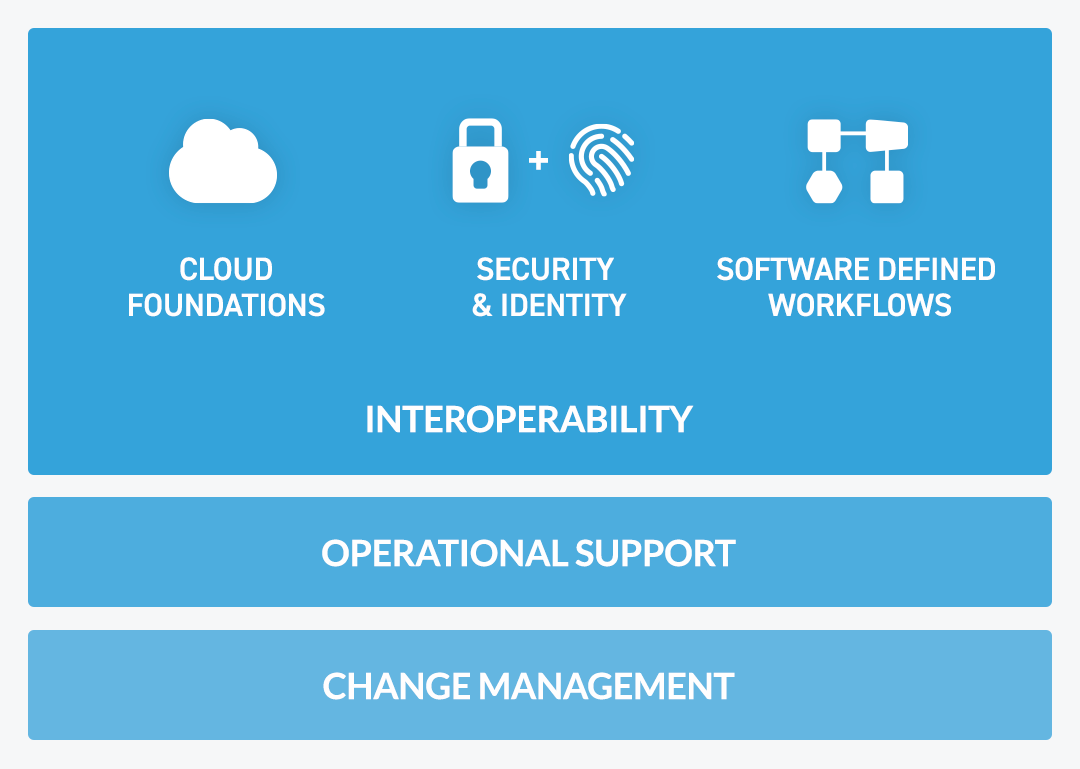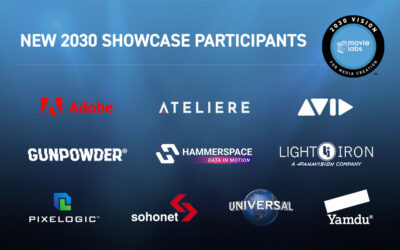It’s mid-2023, we’re about 4 years into our odyssey towards “ProductionLandia” – an aspirational place where video creation workflows are interoperable, efficient, secure-by-nature and seamlessly extensible. It’s the destination. The 2030 Vision is our roadmap to get there. Each year at MovieLabs we check the industry’s progress towards this goal, adjusting focus areas, and generally providing navigation services to ensure we’re all going to arrive in port in ProductionLandia at the same time and with a suite of tools, services and vendors that work seamlessly together. As part of that process, we take a critical look at where we are collectively as an M&E ecosystem – and what work still needs to be done – we call this “Gap Analysis”.
Before we leap into the recent successes and the remaining gaps, let’s not bury the lead – while there has been tremendous progress, we have not yet achieved the 2030 Vision (that’s not negative, we have a lot of work to do and it’s a long process). So, despite some bold marketing claims from some industry players, there’s a lot more in the original 2030 Vision white paper than lifting and shifting some creative processes to the cloud, the occasional use of virtual machines for a task or a couple of applications seamlessly passing a workflow process between each other. The 2030 Vision describes a paradigm shift that starts with a secure cloud foundation, and also reinvents our workflows to be composable and more flexible, removing the inefficiencies of the past, and includes the change management that is necessary to give our creative colleagues the opportunity to try, practice and trust using these new technologies on their productions. The 2030 Vision requires an evolution in the industry’s approach to infrastructure, security, applications, services and collaboration and that was always going to be a big challenge. There’s still much to be done to achieve dynamic and interoperable software-defined workflows built with cloud-native applications and services that securely span multi-cloud infrastructures.
Status Check
But even though we are not there yet, we’re actually making amazing progress based on where we started (albeit with a global pandemic to give a kick of urgency to our journey!). So many major companies including cloud services companies, creative application tool companies, creative service vendors and other industry organizations have now backed the 2030 Vision; it is no longer just the strategy of the major Hollywood studios but has truly become the industry’s “Vision.” The momentum is truly behind the vision now, and it’s building – as is evident in the 2030 Showcase program that we launched in 2022 to highlight and share 10 great case studies where companies large and small are demonstrating Principles of the Vision that are delivering value today.
We’ve also seen the industry respond to our previous blogs on gaps including what was missing around remote desktops for creative applications, software-defined workflows and cloud infrastructures. We can now see great progress with camera to cloud capture, automated VFX turnovers, final color pipelines now technically possible in the cloud, amazing progress on real-time rendering and iteration via virtual production, creative collaboration tools and more applications opening their APIs to enable new and unpredictable innovation.
Mind the Gaps
So, in this two-part Blog, let’s look at what’s still missing. Where should the industry now focus its attention to keep us moving and accelerate innovation and the collective benefits of a more efficient content creation ecosystem? We refer to these challenges as “gaps” between where we are today and where we need to be in “ProductionLandia.” When we succeed in delivering the 2030 Vision, we’ll have closed all of these gaps. As we analyze where we are in 2023 we see these gaps falling into the 3 key categories from the original vision (Cloud Foundations, Security and Identity, Software-Defined Workflows), plus 3 underlying ones that bind them altogether:

In this Part 1 of the Blog we’ll look at the gaps related to these areas. In Part 2 we’ll look at the gaps we view as most critical for achieving each of the principles of the vision, but let’s start with those binding challenges that link them all.
It’s worth noting that some gaps involve fundamental technologies (a solution doesn’t exist or a new standard, or open source project is required) some are implementation focused (e.g., technology exists but needs to be implemented/adopted by multiple companies across the industry to be effective – our cloud security model CSAP is an example here where a solution is now ready to be implemented) and some are change management gaps (e.g., we have a viable solution that is implemented but we need training and support to effect the change). We’ve steered clear of gaps that are purely economic in nature as MovieLabs does not get involved in those areas. It’s probably also worth noting that some of these gaps and solutions are highly related, so we need to close some to support closing others.
Interoperability Gaps
- Handoffs between tasks, teams and organizations still require large scale exports/imports of essence and metadata files, often via an intermediary format. Example: Generation of proxy video files for review/approval of specific editorial sequences. These handovers are often manual, introducing the potential for errors, omissions of key files, security vulnerabilities and delays. See note1.
- We still have too many custom point-to-point implementations rather than off-the-shelf integrations that can be simply configured and deployed with ease. Example: An Asset Management System currently requires many custom integrations throughout the workflow, which makes changing it out for an alternative a huge migration project. Customization of software solutions adds complexity and delay and makes interoperability considerably harder to create and maintain.
- Lack of open, interoperable formats and data models. Example: Many applications create and manage their own sequence timeline for tracking edits and adjustments instead of rallying around open equivalents like OpenTimelineIO for interchange. For many use cases, closing this gap requires the development of new formats, data models, and their implementation.”.
- Lack of standard interfaces for workflow control and automation. Example: A workflow management software cannot easily automate multiple tasks in a workflow by initiating applications or specific microservices and orchestrate their outputs to form an output for a new process. Although we have automation systems in some parts of the workflow the lack of standard interfaces again means that implementors frequently have to write custom connectors to get applications and processes to talk to each other.
- Failure to maintain metadata and a lack of common metadata exchange across components of the larger workflow. Example: Passing camera and lens metadata from on-set to post-production systems for use in VFX workflows. Where no common metadata standards exist, or have not been implemented, systems rarely pass on data they do not need for their specific task as they have no obligation to do so, or don’t know which target system may need it. A more holistic system design however would enable non-adjacent systems to be able to find and retrieve metadata and essence from upstream processes and to expose data to downstream processes, even if they do not know what it may be needed for.
Operational Support
- Our workflows, implementations and infrastructures are complex and typically cross between boundaries of any one organization, system or platform. Example: A studio shares both essence and metadata with external vendors to host on their own infrastructure tenants but also less structured elements such as work orders (definitions of tasks), context, permissions and privileges with their vendors. Therefore, there is a need for systems integrators and implementors to take the component pieces of a workflow and to design, configure, host, and extend them into complete ecosystems. These cloud-based and modern software components will be very familiar to IT systems integrators, but they need the skills and understanding in our media pipelines to know how to implement and monetize them in a way which will work in our industry. We therefore have a mismatch gap between those that understand cloud-based IT infrastructures and software, and those that understand the complex media assets and processes that need to operate on those infrastructures. There are few companies to chose from that have the correct mixture of skills to understand both cloud and software systems as well as media workflow systems, and we’ll need a lot more of them to support the industry wide migration.
- We also need systems that match our current support models. Example: A major movie production can be simultaneously operating across multiple countries and time zones in various states of production and any down system can cause backlogs in the smooth operations. The media industry can work some unusual and long hours, at strange times of the day and across the world – demanding a support environment that can support it with specialists that understand the challenges of media workflows and not just open an IT ticket that will be resolved when the weekday support comes in at 9am on Monday. In the new 2030 world, these problems are compounded by the shared nature of the systems – so it may be hard for a studio or production to understand which vendor is responsible if (when) there are workflow problems – who do you call when applications and assets seamlessly span infrastructures? How do you diagnose problems?
Change Management
- Too few creatives have tried and successfully deployed new ‘2030 workflows’ to be able to share and train others. Example: Parts of the workflow like Dailies have migrated successfully to the cloud, but we’re yet to see a major production running from ”camera to master” in the cloud – who will be the first to try it? Change Management comprises many steps before new processes are considered “just the way we do things.” There are many steps but the main ones we need to get through are:
- Educating and socializing the various stakeholders about the benefits of the 2030 vision, for their specific areas of interest
- Involving creatives early in the process of developing new 2030 workflows
- Then demonstrating value of new 2030 workflows to creatives with tests, PoCs, limited trials and full productions
- Measuring cost/time savings and documenting them
- Sharing learnings with others across the industry to build confidence.
Shortly, we’ll add a Part II to this blog which will add to the list of gaps with those that are most applicable to each of the 10 Principles of the Vision. In the meantime, there’re eight gaps here which the industry can start thinking about, and do please let us know if you think you already have solutions to these challenges!
[1] The Ontology for Media Creation (OMC) can assist in common payloads for some of these files/systems.




